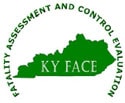Coal Truck Driver Dies in Rollover After Tire on Trailer Fails
Kentucky Case Report: 06KY100
Report Release Date: May 12, 2009
Summary
In the fall of 2006, a twenty-three year old male tractor-trailer driver who was hauling coal, died when a rear outer tire on the trailer failed. After the tire failed, the trailer slipped off the right side of the road, overturned, and went over an embankment. The trailer remained attached to the tractor as both went over the embankment, flipping the entire unit upside down. A witness called emergency medical services who arrived and called the county coroner. The coroner arrived and declared the driver dead at the scene. It was determined by Kentucky State Police that the driver was not wearing a seat belt at the time of the incident. Speed at the time of the crash was not listed in the investigation report. Toxicology tests detected tramadol, oxycodone, and hydrocodone in the driver’s system at the time of the crash.
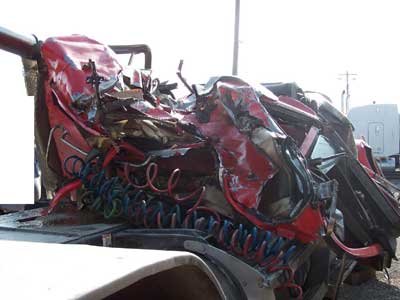
|
|
Photograph of semi involved in crash.
Photograph taken by KY FACE personnel. |
To prevent future occurrences of similar incidents, the following recommendations have been made:
- Recommendation No. 1: Employers should require drivers to perform pre-trip and post-trip inspections on the tractor and trailer prior to operation.
- Recommendation No. 2: Employers should require the use of seat belts while operating a commercial vehicle.
- Recommendation No. 3: Companies should provide professional training for company truck drivers.
- Recommendation No. 4: Stabilizer and sensory systems should be mandatory equipment on all commercial vehicles.
- Recommendation No. 5: Comprehensive expanded new-hire prescreening and after-hire random drug/ alcohol testing policies should be implemented and enforced for substance abuse.
Background
The Kentucky Fatality Assessment and Control Evaluation (FACE) program conducted interviews with the local coroner, Kentucky State Police, the towing company, toxicologist, and a witness to the incident.
An interstate authorized-for-hire, trucking company licensed to carry coal/coke/sand, had been in business for over fifteen years when the incident occurred. The tractor trailer driver was an employee of a family owned business. It is unknown how long the driver had driven professionally, and what type of driver training he had received. The driver made three to five trips per day hauling coal from a mine site to a coal tipple approximately 40 miles one way.
Temperatures on the day of the incident ranged from fifteen degrees Fahrenheit to forty-four degrees Fahrenheit. There was no reported precipitation.
Investigation
In the fall of 2006, the driver of a coal semi-tractor and trailer was traveling north on a two lane federal highway at approximately 2:40 PM. The total weight of the truck was 120,000 lbs which was within the legal weight limit. He had been hauling coal all day from a mining site to a tipple site 40 miles away, and was approximately halfway into the route when the crash occurred. Upon approach to the crash scene, the two-lane roadway straightened out from a moderate left-hand curve with a guard rail into a straight-away with a slight upward incline. The guard rail ended at the edge of the curve. The edge of the roadway blended smoothly into a band of gravel approximately four feet wide that quickly narrowed down to one foot wide before dropping off over the side of a steep embankment. The embankment was covered by dead grass and leaves. A second guard rail was in place on the shoulder of the road approximately thirty feet from where the first rail ended and where the gravel strip began to narrow. It was daylight and weather conditions were clear, the roadway was made of asphalt and was dry. The legal speed limit was fifty-five miles per hour.
A witness in a vehicle following the tractor-trailer reported that as the driver entered the left-hand curve, the trailer began leaning to the right. As the roadway straightened, the trailer overturned onto its side between the two guard rails as it went over the embankment. The tractor and trailer remained attached and the tractor was flipped first onto the passenger side and then onto the top. The cab of the tractor caught on the second guard rail. A power utility pole in place beside the roadway and several feet down the embankment was snapped in two when struck by the side of the trailer. The tractor came to rest upside down on the guard rail, perpendicular to the road, with the trailer laying down the side of the embankment. The entire load of coal was dumped at the foot of the embankment.
Accident reconstruction conducted by the Kentucky State Police revealed that there were 284 feet of skid marks prior to the point where the tractor overturned. The tractor then skidded approximately 82 feet on its side and top before coming to rest upside down and on top of the guard rail. There was approximately 120 feet of damaged guard rail.
At approximately 2:40 PM, a witness in the front yard of his house next to the crash scene reported that he heard a loud sound like a tire blowing, saw the truck and tractor overturn, and called 911. The witness reported that the first emergency responders, the local volunteer fire department, began arriving “within minutes” and were followed by the state police and ambulance personnel. Ambulance personnel called the county coroner at 2:50 P.M. The coroner arrived and pronounced the driver dead at the scene at 3:20 P.M. The local fire department controlled traffic and worked for two hours using a “Jaws of Life” hydraulic device to remove the driver from the tractor. Kentucky State Police and the county coroner stated that there was nothing found in the area that would have caused a tire to blow. A gash was found in the middle rear outer tire. Toxicology tests detected tramadol, oxycodone, and hydrocodone in the driver’s system at the time of the crash.
Cause of Death
The death certificate states the cause of death was due to “blunt force trauma to head, chest and lower extremities” sustained in a “coal truck accident.”
Recommendations and Discussion
Recommendation No. 1: Employers should require drivers to perform pre-trip and post-trip inspections on the tractor and trailer prior to operation.
Federal Motor Carrier Safety Administration regulations CFR 396.13 and CFR 396.11 require commercial motor vehicles to be inspected before driving the vehicle and at the completion of the day?s work. CFR 396.3 requires companies to not only inspect every commercial vehicle, but to keep the vehicle properly repaired and maintained. Reports are to be completed and available for the next driver to review as part of their inspection of the vehicle. Companies should require drivers to complete the Department of Transportation Driver?s Vehicle Inspection Report, DVIR, (Attachment 1) and to turn them into the office each day. If the driver finds a defect detrimental to safety, it is recommended that the equipment be taken to the proper mechanic for repairs. The report lists important aspects of the vehicle such as tires, battery, body, brakes, clutches, wheels and rims, windshield wipers, etc., which the driver is required to inspect each time the semi is operated. There is a space on the form for the driver to make notes for items not listed on the report that may need to be addressed immediately or in the future. After completing the report, the driver either signs that the vehicle is in satisfactory condition or that defects need correction or repair before the vehicle is returned to service.
Recommendation No. 2: Employers should require the use of seat belts while operating a commercial vehicle.
Kentucky and Federal law both require commercial drivers to wear seat belts when operating a commercial vehicle. Kentucky Revised Statute 189.125(6) requires drivers and all passengers to be restrained by properly adjusted and fastened seatbelts. 49 Code of Federal Regulations §392.16-Use of seat belts, states that a commercial vehicle is equipped with a seatbelt, and the driver must properly restrain himself/herself with the seatbelt. The purpose of the seat belt is to keep the driver restrained behind the wheel of the vehicle in case of a crash, preventing the driver from being thrown from the vehicle, being tossed around inside the vehicle, and to assist the driver maintaining control of the vehicle. In this incident the tractor was manufactured in 2002 and was equipped with seat belts. A program by the Federal Motor Carrier Safety Administration, “Commercial Vehicle Safety Belt Program”, and a manual, “Increasing Safety Belt Use in Your Companyexternal icon” are available for company owners to use to train their drivers on the importance of seatbelt use. The manual can be found at: http://www.fmcsa.dot.gov/safety/safety-belt/increasing-safety-belt-use-your-company-manual (Link Updated 4/8/2015)
Recommendation No. 3: Companies should provide professional training for company truck drivers.
Company truck drivers should receive formal professional driver training. This training should include defensive driving techniques, how to handle vehicle malfunctions such as tire blow-outs, driving on two-lane highways with steep drop-offs without shoulders, adverse weather and road conditions, and dealing with the general motoring public. According to two truck driver training schools, defensive driving techniques would include looking eight to ten seconds ahead of the vehicle. This gives the driver time to judge appropriate speed for road conditions and to adjust the vehicle’s speed accordingly.
Recommendation No. 4: Stabilizer and sensory systems should be mandatory equipment on all commercial vehicles.
The semi-tractor was manufactured in 2002 and was not equipped with a stabilizer system. When an automatic braking system is applied by the driver prior to making an avoidance maneuver, the ABS assists the semi-tractor trailer from jackknifing. When a vehicle is equipped with a stabilizer and sensory system, the stabilizer system can sense incorrect vehicle movement. Independent of driver input or action, the stabilizer system override will be deployed and prevent the semi-tractor trailer from a jackknife, or roll over.
Recommendation No. 5: Comprehensive expanded new-hire prescreening and after-hire random drug/ alcohol testing policies should be implemented and enforced for substance abuse.
49 CFR 382.301 requires employers to perform pre-employment screening for controlled substance abuse on every new driver hired. Currently 49 CFR §40.85 requires companies to perform a five panel limited drug screen urine test for marijuana, cocaine, opiates, phencyclidine, and amphetamines performed prior to hiring new drivers. The Kentucky Transportation Cabinet should require companies to perform expanded drug testing separate from the Federal Department of Transportation?s panel that might include drugs such as barbiturates, benzodiazepines, depressants, ecstasy, methadone, methamphetamines, oxycodone, tricyclic antidepressants, and other currently popular recreational drugs. By performing this separate drug panel, companies can better screen applicants and understand substance abuse; for example, the driver in this case tested positive for presumptive presence of benzodiazepine, a depressant. According to 49 CFR 382.305(b)(2), employers are required to annually test 50% of company drivers for controlled substances.
References
- 49 Code of Federal Regulations 396.13 Driver Inspectionexternal icon, http://www.fmcsa.dot.gov/rules-regulations/administration/fmcsr/fmcsrruletext.aspx?reg=396.13 (Link Updated 11/15/2011)
- 49 Code of Federal Regulations 396.11 Driver Vehicle Inspection Report(s)external icon, http://www.fmcsa.dot.gov/rules-regulations/administration/fmcsr/fmcsrruletext.aspx?reg=396.11(Link Updated 11/15/2011)
- 49 Code of Federal Regulations 396.3 Inspection, Repair and maintenanceexternal icon, http://www.fmcsa.dot.gov/rules-regulations/administration/fmcsr/fmcsrruletext.aspx?reg=396.11(Link Updated 11/15/2011)
- Kentucky Revised Statute 189.125(6) – Seat belts
- 49 Code of Federal Regulations §392.16-Use of seat beltsexternal icon http://www.fmcsa.dot.gov/safety/safety-belt/increasing-safety-belt-use-your-company-manual (Link Updated 4/8/2015)
- Code of Federal Regulations, Department of Transportation, Federal Motor Carrier Safety Administration, Part 393: Parts and Accessories Necessary for Safe Operation, Subpart C, 393.55 Antilock brake systemsexternal icon, http://www.fmcsa.dot.gov/rules-regulations/administration/fmcsr/fmcsrruletext.aspx?reg=393.55 (Link Updated 11/15/2011)
- Guidelines for Driving with Bendix Electronic Stability Program Technology, http://www.youtube.com/watch?v=85ZmW1gqIOc (Link no longer available 3/20/2013)
- Guidelines for driving with Meritor Wabco radar based collision system,
- 49 Code of Federal Regulations Part 382: Controlled substances and alcohol use and testing, Subpart C, Tests required, 382.301 Pre-employment testingexternal icon http://www.fmcsa.dot.gov/rules-regulations/administration/fmcsr/FmcsrGuideDetails.aspx?menukey=382 (Link Updated 11/15/2011)
- 49 Code of Federal Regulations §40.85: Part 40: Procedures for transportation workplace drug and alcohol testing programs, Subpart F – Drug testing laboratoriesexternal icon http://www.dot.gov/odapc/part40 (Link Updated 3/20/2013)
- 49 Code of Federal Regulations Part 382: Controlled substances and alcohol use and testing, Subpart C, Tests required, 382.305(b)(2) Random testingexternal icon http://www.fmcsa.dot.gov/rules-regulations/administration/fmcsr/
fmcsrruletext.aspx?reg=382.305 (Link Updated 11/15/2011)
Acknowledgements
- Local coroner
- Kentucky State Police
Photographs
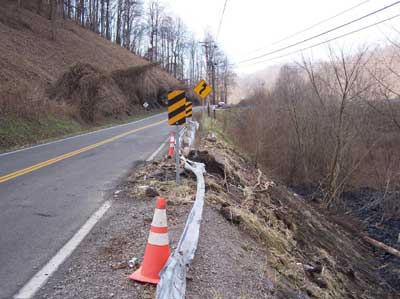
|
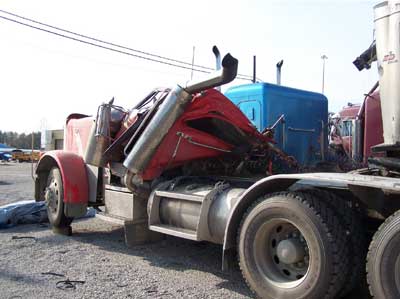
|
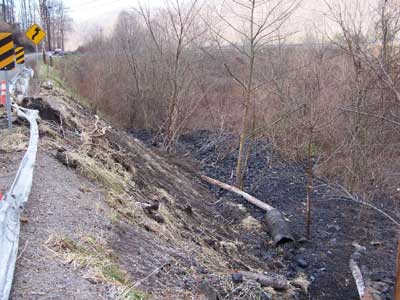
|
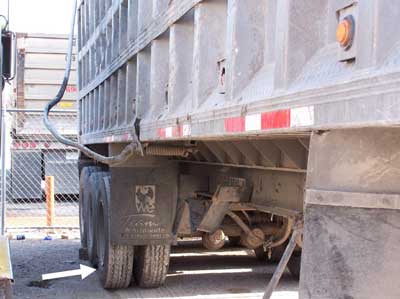
|
|
Photograph of tire with hole in it. |
Attachment 1: Copy of Department of Transportations Daily Driver’s Vehicle Inspection Report
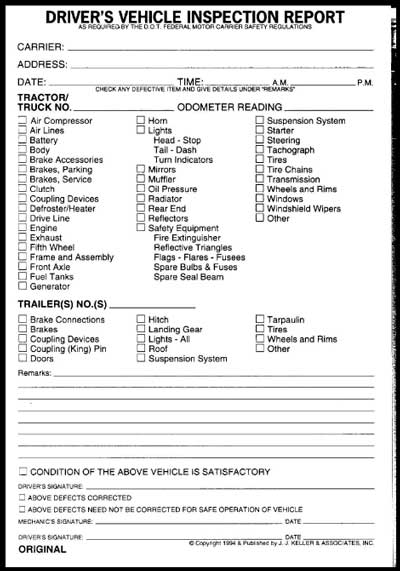
|
Kentucky FACE Program
The Kentucky Fatality Assessment & Control Evaluation Program (FACE) is funded by a grant from the Centers for Disease Control and the National Institute of Safety and Health. The purpose of FACE is to aid in the research and prevention of occupational fatalities by evaluating events leading to, during, and after a work related fatality. Recommendations are made to help employers and employees to have a safer work environment. For more information about FACE and KIPRCexternal icon, please visit our website at: www.mc.uky.edu/kiprc/. (Link updated 3/27/2013)
To contact Kentucky State FACE program personnel regarding State-based FACE reports, please use information listed on the Contact Sheet on the NIOSH FACE web site. Please contact In-house FACE program personnel regarding In-house FACE reports and to gain assistance when State-FACE program personnel cannot be reached.

